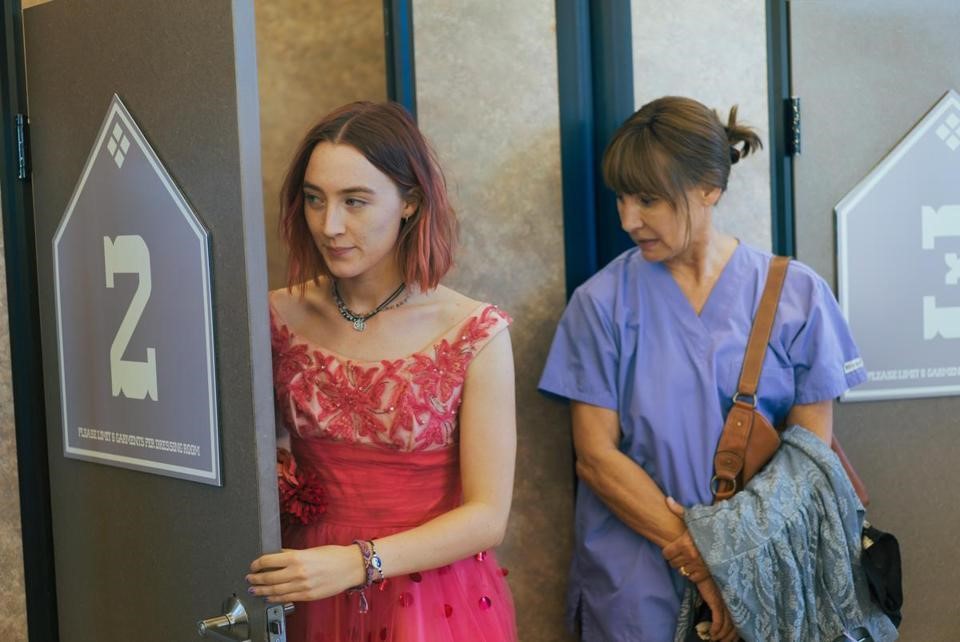Best Versions: Lady Bird, Identity, and Separation
/The 2018 Oscars featured a whole slew of movies concerned with race, gender, and politics, but one theme I saw form as a sort of connective tissue throughout most seemed to be that of motherhood. Three Billboards featured a vengeful mother-goddess portrayed by Frances McDormand, who got the Best Actress trophy. Get Out and Phantom Thread featured male protagonists who had each formulated a deep-rooted psychological bond between their portrayed identities and the loss of their own mothers. The Shape Of Water? Well, the female protagonist took care of a monster by feeding him eggs, which has some heavily implied symbolism. But no film looked as directly on at the relationship between mothers and their children as Lady Bird, which focused on a young heroine struggling to shape her own identity and separate from her mother figure by any means necessary -- even if it means jumping out of a moving car.
This “separation from the mother” aspect of the heroine’s journey comes from Maureen Murdock’s look at that exact phenomena in modern mythology, The Heroine’s Journey: Woman’s Quest for Wholeness. In it, Murdock supposes that while Joseph Campbell’s hero’s journey is all well and good for men, women partake in their own version of the journey which is more focused on separating from the female aspects of their identity, entering the world of the masculine, and then reuniting with their feminine selves in order to become a “whole” figure.
This actually makes a lot of sense in terms of general mythology. Many myths have, for their ultimate achievement, an ascension to the godhead—which involves becoming both male and female—a whole, complete version of the human shell we’re stuck inside of.
Lady Bird herself confronts this struggle with identity head on when she demands to be called by a name of her own choosing: Lady Bird. This is her first step in forging her own identity. But in forging one’s own identity, a confrontation explodes. The person with whom we have originally created our own identity from—the image we have plagiarized in trying to create ourselves—comes from our parents. Just as God supposedly created mankind from his own image, so too do we create our own image from the gods that raised us.
Marion McPherson, Lady Bird’s mother, spends most of the film openly criticizing her daughter’s appearance and intellectual prowess. This conflict over Lady Bird’s identity ripples out to the other aspects of her life, including the men she becomes involved with, the friends she chooses, and the colleges she wants to apply to. When Lady Bird finally asks her mother why she can’t just approve of her decisions, Marion says, “I want you to be the very best version of yourself that you can be.”
But as Lady Bird counters, “what if this is the best version?”
As Murdock explains, there are two poles of motherhood in mythology. There is the “Great Mother who embodies limitless nurturance, sustenance, and protection and the Terrible Mother who represents stasis, suffocation, and death.”
Lady Bird seeks the Great Mother from Marion, but is constantly assailed by the negative archetype of the Terrible Mother. Marion represents stasis and suffocation for Lady Bird in that she seems determined to keep Lady Bird close to home in Sacramento, California, while Lady Bird wants to go to more culturally inclined places like, “New York, or Connecticut, or New Hampshire.”
Marion’s desire to keep Lady Bird close is akin to death for Lady Bird, and this drives her to separate from her mother. The cast she wears for most of the film seems to represent this struggle -- it was, after all, her jumping from the car away from her mother that get her there in the first place.
But the journey for Lady Bird must conclude with her separating from the mother and forging her own identity, no matter what. She enlists the father as an ally in this journey, who helps get her the financing she needs to attend college on the east coast. Even if Marion were not the smothering embodiment of the Terrible Mother, however, Lady Bird might have to cast her in that role to separate from the womb-like protection of the nurturing mother and forge her own identity.
As Murdock explains, “in adulthood many people respond to female power and often to their own mothers in terms of the Terrible Mother aspect of the archetype” in order to complete separation, forge their own identities, and become the best versions of themselves. In doing so, “they fail to see their mother’s life in the context of the historical period in which she lived, her family background, and the opportunities available to women at that time.”
This is exactly what Lady Bird does as she sees Sacramento and her mother’s role in keeping her there as a smothering form of stasis and eventual death. However, once she does complete the separation, Lady Bird begins to recognize these aspects of her mother, and ends the movie with a message left for her in which she acknowledges both her and her mother’s feelings of Sacramento and thanks her mother for the journey.
Greta Gerwig shows this resolution of identity perfectly by intercutting scenes of both Lady Bird, who is now calling herself by the name her parents gave her, Christine, and Marion driving through Sacramento at sunset. Once the separation is complete, the female can forge ahead with her own identity and arrive at peace with the Terrible Mother archetype that once hounded her, allowing the Great Mother to once again take hold in her consciousness and lead her into the world she now finds herself needing to become a part of.
Next time, I'll take a further look at this aspect of the heroine’s journey through the mirrors of perhaps the most famous franchise and example of hero mythology out there: Star Wars.






